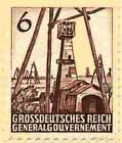Enter Text
Second World War in Galicia 1939-1945
August 23, 1939
Poland is partitioned by the Nazi-Soviet Non-Aggression Pact signed by German Foreign Minister Von
Ribbentrop and Soviet Foreign Minister Molotov.
September 1, 1939
World War II begins when German troops invade Poland.
September 17, 1939
The Soviets march into Galicia, occupy Lwów and the rest of Galicia east of the San River. Drohobycz and
Borysław are occupied by the Germans. Jews are tormented during this period with humiliating tasks.
September 24, 1939
German troops leave Drohobycz and Borysław to be replaced by the Soviet occupation. The lands to the
west become part of the German-occupied Generalgovernment.
Coat of Arms of the Ukrainian Soviet Socialist Republic
Soviet Occupation
November 1, 1939
Soviet-occupied Galicia becomes part of the Ukrainian SSR. In the summer, Jewish refugees who had come
to Borysław from western Poland are deported to the Soviet interior.
1940
World War II begins when German troops invade Poland.
A German stamp which was printed and never released for the German Reich's General Government (the Nazi-era occupational government of Poland). It portrays the Borysław oil field with a wood-enclosed derrick and its adjacent wooden shed which housed pumping machinery. Several simpler tripod frames for cable-tool drilling are also visible in both the foreground and background.
Breaking their non-aggression pact, Germany invades the Soviet Union under the plan code-named
Operation Barbarossa and German troops occupy Borysław and Drohobycz. Many young Jews in
Drohobycz and Borysław join the Soviet army. Others flee with the retreating Soviet authorities.
German Occupation
June 22, 1941
June 30, 1941. 8:00pm
German soldiers enter Drohobycz and Borysław and quickly take over Truskawiec, Schodnica, Urycz, and
other towns.
When the German troops arrive, they find the prisons of many eastern Galician towns full of the bodies
of prisoners that the Soviet occupiers murdered shortly before their retreat. A great number of these
had been political prisoners, among them many Ukrainians who opposed the Soviet regime. The
discovery of the bodies sparks Ukrainian and Poles to run wild and kill Jews who are collectively blamed
for supporting Bolshevism. The pogrom is led by Ukrainian nationalists commemorating "Bandera Day".
(Stepan Bandera was a leader of the Nationalist Ukrainian organization (OUN) that supported Nazi
Germany.) The pogrom continues for three consecutive days. In Borysław, many Jews are rounded up
and forced to clean out the bodies from the prison, wash them in Pańska Street, and prepare them for
burial. All the while, they are beaten and brutally treated.
July 1-4, 1941
By this date, the murders and plundering have stopped. The German soldiers, who have not actively
participated this first progrom, drive through the streets and shoot Jews who, badly wounded lie in the
streets. 183 are buried in the Jewish cemetery of Borysław. In Schodnica, the Ukrainian militia murder
Jews, destroy houses and property, and plunder for two weeks. The German Security Police
(Sicherheitspolizei or SIPO) arrive in Drohobycz. They and other security organizations, with the assistance
of the Ukrainian militia, will oversee the persecution of the Jews for the remainder of the occupation. Felix
Landau, a member of the SIPO, oversees the Jewish labour assignments. He takes over the former Jewish
Home for the Aged and the "Villa Himmel" as his headquarters. In these first days of the occupation, Jews,
under pain of death, are forced to wear armbands. A Judenrat or Jewish Council is established with members
taken from the prewar community leaders. In Drohobycz the Judenrat is led by Drs Isaac Rosenblatt and
Maurycy Ruhrberg and in Borysław by Michael Herz, whose headquarters is established in the former
Hebrew school. The liaison between the Judenrat and the German Security Police is Eduard Goldmann.
Labour bureaus (Arbeitsämte) are established to organize forced labour for all Jews between the ages of
sixteen and sixty-five. In Drohobycz, the office of the Arbeitsamt is in the former Jewish orphanage on
Sobieski Street. More restrictions are forced upon the Jews of the town. Jewish stores are looted and Jews
are restricted from moving freely about the city or on selected streets.
July 4, 1941
July 11, 1941
Forty members of the Jewish intelligentsia and some Ukrainians are arrested.
July 12, 1941
Twenty-three of those arrested are taken to Bronica forest, forced to dig their graves, and then shot.
Jews are gradually subjected to even more restrictions. Their properties are confiscated. Their
businesses are taken over and plundered, or due to the murder of their owners, abandoned. Jews are
now forbidden to enter public buildings, attend theatre or cinema, or use public transportation or cars.
The Nazis appropriate all radios, telephones, furs, and jewelry owned by Jews. Their legal rights are
suspended. Jewish food rations are severely restricted. In order to survive, they are forced to sell their
possessions.
August to October, 1941
In Drohobycz, Felix Landau shoots seventeen Jews who did not report for work because of the ill
treatment they were forced to endure. He demands that the Judenrat bring these workers for execution
within an hour or 100 hostages will be taken and killed. The Judenrat brings some workers but cannot
find those who fled. As punishment, Landau kills twenty in the Judenrat office.
July 22, 1941
October, 1941
Areas restricted to Jews begin to be formed in many towns in eastern Galicia.


